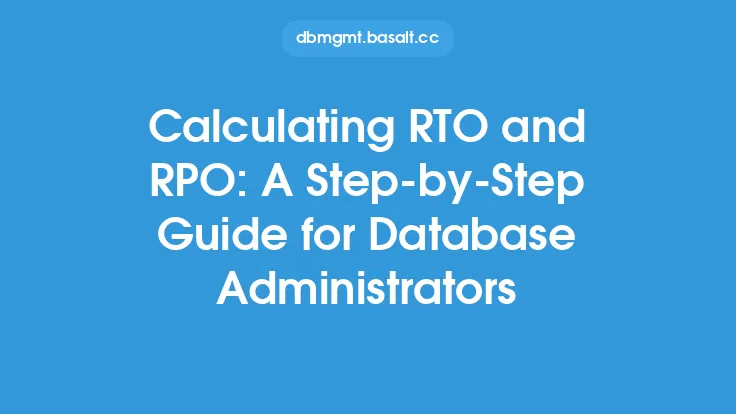When it comes to database configuration tuning, the goal is to optimize the performance of the database to handle the workload efficiently. This involves a series of steps that help in identifying the bottlenecks, analyzing the database configuration, and making the necessary adjustments to achieve maximum performance. In this article, we will delve into the step-by-step approach to database configuration tuning, providing a comprehensive guide on how to optimize database performance.
Introduction to Database Configuration Tuning
Database configuration tuning is a critical aspect of database administration, as it directly impacts the performance and efficiency of the database. The process involves analyzing the database configuration, identifying bottlenecks, and making adjustments to optimize performance. This can include tweaking configuration parameters, adjusting resource allocation, and optimizing database structures. The goal of database configuration tuning is to ensure that the database can handle the workload efficiently, providing fast and reliable access to data.
Identifying Performance Bottlenecks
The first step in database configuration tuning is to identify performance bottlenecks. This involves monitoring the database's performance, analyzing logs, and using tools to identify areas where the database is struggling. Common performance bottlenecks include CPU usage, memory usage, disk I/O, and network latency. By identifying these bottlenecks, database administrators can focus their tuning efforts on the areas that will have the greatest impact on performance.
Analyzing Database Configuration
Once performance bottlenecks have been identified, the next step is to analyze the database configuration. This involves reviewing configuration parameters, such as buffer pool size, sort area size, and log buffer size. Database administrators should also analyze database structures, including table and index design, to identify areas for optimization. Additionally, analyzing database workload, including query patterns and transaction volumes, can help identify opportunities for tuning.
Adjusting Configuration Parameters
Adjusting configuration parameters is a critical step in database configuration tuning. This involves tweaking parameters, such as buffer pool size, to optimize memory usage and improve performance. Database administrators should also adjust parameters, such as sort area size and log buffer size, to optimize disk I/O and reduce latency. Additionally, adjusting parameters, such as query optimization parameters, can help improve query performance and reduce the load on the database.
Optimizing Database Structures
Optimizing database structures is another critical step in database configuration tuning. This involves analyzing table and index design to identify areas for optimization. Database administrators should consider reorganizing tables, rebuilding indexes, and creating new indexes to improve query performance. Additionally, optimizing database structures, such as partitioning and clustering, can help improve data access and retrieval.
Testing and Validation
Once adjustments have been made to the database configuration, the next step is to test and validate the changes. This involves running benchmarks, analyzing performance metrics, and monitoring the database's behavior. Database administrators should test the database under various workloads, including peak and off-peak periods, to ensure that the changes have improved performance. Additionally, validating the changes involves verifying that the database is still functioning correctly and that data integrity has not been compromised.
Ongoing Monitoring and Maintenance
Finally, ongoing monitoring and maintenance are critical aspects of database configuration tuning. This involves continuously monitoring the database's performance, analyzing logs, and using tools to identify areas for further optimization. Database administrators should also perform regular maintenance tasks, such as updating statistics, rebuilding indexes, and running backups, to ensure that the database remains optimized and performing well.
Best Practices for Database Configuration Tuning
When it comes to database configuration tuning, there are several best practices that database administrators should follow. These include:
- Monitoring performance regularly to identify bottlenecks and areas for optimization
- Analyzing database configuration and workload to identify opportunities for tuning
- Adjusting configuration parameters and optimizing database structures to improve performance
- Testing and validating changes to ensure that they have improved performance
- Continuously monitoring and maintaining the database to ensure that it remains optimized and performing well
- Documenting changes and maintaining a record of database configuration and performance metrics
- Staying up-to-date with the latest database technologies and best practices to ensure that the database remains optimized and performing well.
Common Database Configuration Tuning Mistakes
When it comes to database configuration tuning, there are several common mistakes that database administrators should avoid. These include:
- Over-tuning the database, which can lead to decreased performance and increased complexity
- Under-tuning the database, which can lead to poor performance and decreased efficiency
- Failing to monitor and maintain the database, which can lead to decreased performance and data integrity issues
- Failing to test and validate changes, which can lead to decreased performance and data integrity issues
- Failing to document changes and maintain a record of database configuration and performance metrics, which can lead to decreased performance and data integrity issues.
Conclusion
In conclusion, database configuration tuning is a critical aspect of database administration, as it directly impacts the performance and efficiency of the database. By following a step-by-step approach to database configuration tuning, database administrators can identify performance bottlenecks, analyze database configuration, adjust configuration parameters, optimize database structures, test and validate changes, and perform ongoing monitoring and maintenance. By following best practices and avoiding common mistakes, database administrators can ensure that their databases are optimized and performing well, providing fast and reliable access to data.





